
The Business of Fashion
Agenda-setting intelligence, analysis and advice for the global fashion community.

Agenda-setting intelligence, analysis and advice for the global fashion community.
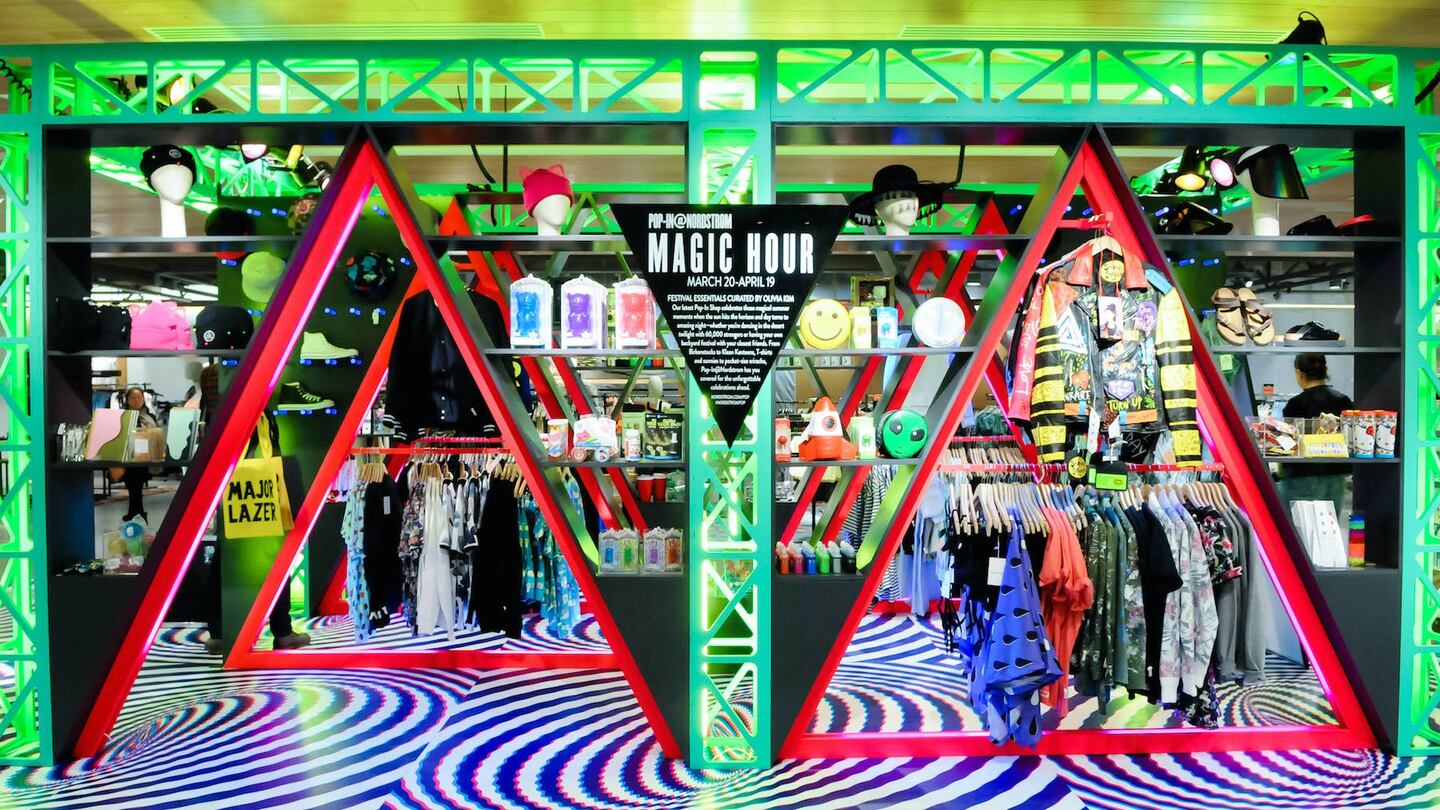
NEW YORK, United States — On the evening of December 15th, the air in the first floor of Bergdorf Goodman was flooded with 'oohs' and 'ahs,' prompted by the sparkling baubles finely displayed at the unveiling of the New York retailer's newly renovated jewellery floor. Executive vice president Linda Fargo oversaw the project, choosing matte pearl grey paint to refresh the walls and stone flooring worthy of the chic heels that would glide across it. The look of the new space is not so much trendy, but refined and softly feminine. "I always like to have something old, something new," Fargo says. "For instance, the first floor of Bergdorf Goodman will never not have a chandelier. It might be a new chandelier, but we won't use modern light fixtures." A private room, the walls panelled in faceted Koto wood, serves as a sort of VIP corridor for those who would like a more private shopping experience when trying on six-figure gems.
Those following the Great Department Store Wars of 2015 know that this particular facelift is just one of many initiatives Bergdorf Goodman and its competitors have planned over the next five years, seeking to bring back the magic to businesses built on nostalgia. Saks, too, is undergoing a major overhaul, pouring $250 million into the renovation of its Fifth Avenue store. Neiman Marcus and Nordstrom are entering the New York City market for the first time in their respective histories, while Barneys New York is continuing to reposition itself with the opening of its downtown Manhattan flagship in 2016.
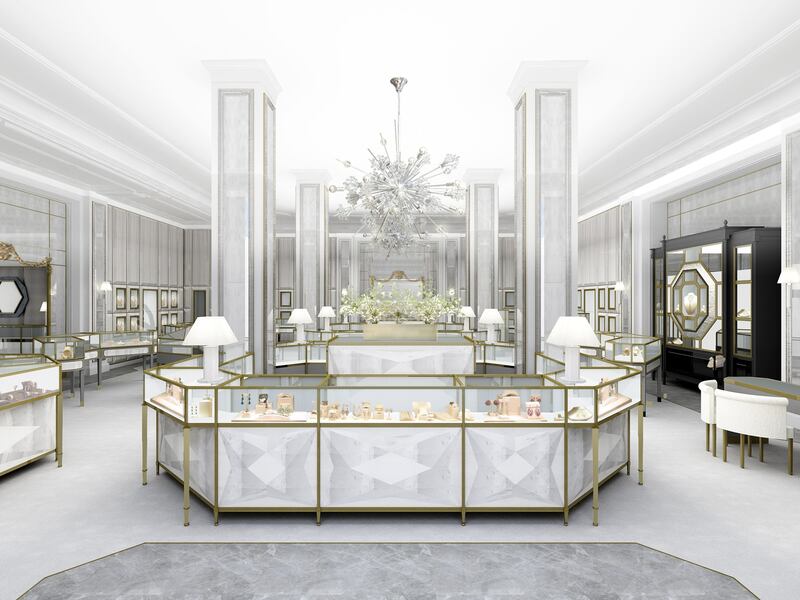
The Fine Jewellery Area of Bergdorf Goodman | Source: Courtesy
These overtures feel particularly timely given that it is harder than ever to attract shoppers. Just a day before the celebration of the jewellery floor at Bergdorf Goodman, its owner, Neiman Marcus Group (NMG), announced that sales in stores open at least one year decreased by 5.6 percent in the first quarter of the 2016 fiscal year. It was the first time same-store sales had decreased in the past six years. NMG also reported a net loss of $10.5 million in the quarter, compared with a $200,000 profit in the first quarter of 2015. (The results suggest that the company’s initial public offering, which it filed for in August 2015, will be postponed until next year.) At Saks Fifth Avenue, same store sales fell 3.6 percent in the most recent fiscal quarter. Macy’s saw that same figure drop 3.6 percent. And even Nordstrom, which has consistently outperformed its peers on the stock market, only saw comparable store sales inch up by 0.9 percent in its last quarter. Barneys New York may be the bright spot, reporting that sales are up year-over-year. However, as a private company, it does not release specific figures.
ADVERTISEMENT
Slowdown and significant challenges
There are reasons for the slowdown: namely, the strength of the dollar, which has deterred foreign tourists from spending in the US, as well as the warm weather, which has impeded shoppers from buying big-ticket items like winter coats and cashmere sweaters. While consumer spending in the US rose slightly in October 2015 — just 0.1 percent — the University of Michigan's consumer sentiment index for December 2015 was 91.8, nearly a two-point drop from last year. (The index measures confidence in spending.)
But the challenges facing department stores, particularly those that deal in luxury goods, are much greater than this seasonal blip. To be sure, there is a significant transformation underway in how goods are bought and sold. It started with the advent of e-commerce, but now stretches far beyond any one channel. While department stores have rushed to catch up online with the likes of Net-a-Porter — by offering marginally better customer service than in the past, with perks like in-store pick-up — the push and pull between bricks and clicks is no longer the story. Instead, it’s the customer herself who has changed: she or he is more discerning, more educated, and more demanding than ever, whether browsing on a URL or a lushly carpeted sales floor. Not only are consumers today after the best price, they are also more willing to research their purchases. In a 2015 Accenture survey of 6,000 consumers — 1,707 of whom were millennials — 41 percent said they practice show-rooming, or the act of looking at merchandise in store and purchasing it online later. What’s more, the past thirty years marked the dramatic rise of the standalone store. Today, brands have a direct relationship with the customer through their own outposts, which wield higher margins.
What’s clear is that the role of the department store must be redefined. “Today, the customer dictates how she is going to shop,” says Robert Burke, chief executive of advisory firm Robert Burke Associates. “The only way for the department stores to compete and be different is to control the experience, assortment and presentation, and to be highly edited and curated. The brands are stronger than ever. How do department stores take a more unique point of view?”
Compelling you to step inside
The first step is convincing customers to make the trip. Discounts are a good, if not permanent, solution. Last November, stores including Saks Fifth Avenue, Neiman Marcus, as well as online retailer Net-a-Porter, held pre-Thanksgiving promotions the Wednesday before the national holiday — in order to drum up business prior to Black Friday. Earlier in the fall, Barneys New York issued gift cards of varying values to many of its customers.
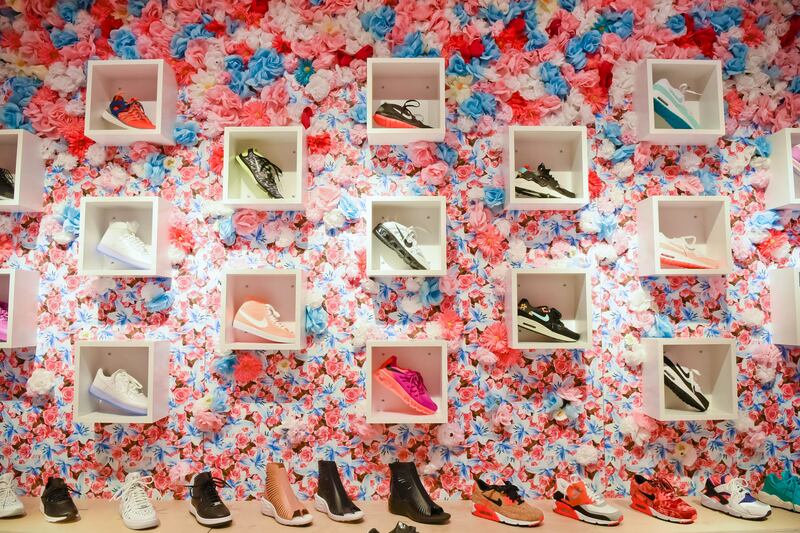
Nordstrom's Nike Pop-In Store Outfit | Source: Courtesy
But price incentives only reinforce the vicious cycle that is partially to blame for the current climate. When prices are slashed prematurely, profits shrink for both the retailer and the designer, and consumers become accustomed to buying things on sale. "The biggest problem in retailing in America is that there is a huge amount of discounting," says Barneys New York chief executive Mark Lee. "It's a promotional environment."
ADVERTISEMENT
A less controversial way to drive foot traffic is through in-store events. At Saks Fifth Avenue, for instance, chief executive Marc Metrick says that, along with the typical celebrity appearances — like Michael Kors trunk shows and Bobbi Brown book signings — the retailer has begun to host seasonal cocktails at its regional locations, where fashion director Roopal Patel or chief merchant Tracy Margolies present trend reports. "Even if they don't transact at that moment, you've now triggered a connection with them," Metrick says. "That will translate to another visit with an intent to purchase."
Specially branded sections of the store, such as the aforementioned jewellery boutique at Bergdorf Goodman or Saks Fifth Avenue’s shoe department, can also be a boon. None have been so outwardly lauded, though, as Nordstrom’s Pop-In, a rotating pop-up shop curated by vice president of creative projects Olivia Kim. Every four-to-eight weeks, Kim — a former buyer at Opening Ceremony — and her team of four build a new concept within Nordstrom’s Seattle flagship. Online, the microsite is re-skinned. Partners have included Liberty of London, Topshop, Paris’s Merci, and most recently, Kim’s old stomping ground, Opening Ceremony. Next up: a Hay Mini Market, featuring the Danish design-firm’s full range of stationery. “We don’t want it to feel temporary,” Kim says. “With every change, we want the customer to walk in feeling like they’re somewhere different.”
Convincing you to stick around
Once a store manages to beckon a customer through its doors, how does it persuade her to stick around? The renovation of Saks Fifth Avenue is grounded in this question. Along with a complete revamp of the look and feel of the space that will include the installation of a spiral staircase — while leaving the storied vintage elevators in tact — the company also plans on moving the beauty department to the second floor, complete with private treatment rooms, while handbags will now dominate the first floor. “Two highly productive businesses — luxury leather goods and beauty — are picking up space,” Metrick says. “From an environmental standpoint, they both get elevated.” Other lavish upgrades include an outpost of Paris restaurant L’Avenue and the introduction of the Vault, a fine jewellery concept on the ground level. More natural light will be filtered into the store so that it feels less like a “casino.” Metrick is even installing a juice bar and a cocktail bar. “Shopping at the store is no longer a utility,” he says. “Now it has to be theatre and entertainment.”
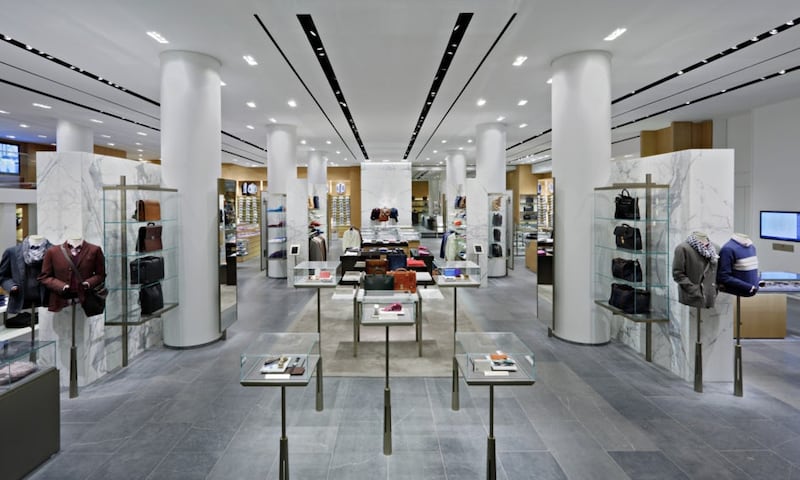
Barneys New York Men's Department | Source: Courtesy
To be sure, retailers across the board believe that the physical layout of each store — and how brands are merchandised within that layout — plays a significant role in how much the shopper enjoys her experience. In 2013, Barneys announced that it would rebrand its remaining CO-OP locations as Barneys New York. The mix of products changed, too. At the Barneys store on Atlantic Avenue in Brooklyn, NY, the assortment is less focused on price than in the past. (Brands currently represented include Stella McCartney, Dries Van Noten, A.L.C. and ATM Anthony Thomas Melillo.) While there are still certain delineations in the retailer's Madison Avenue flagship — aspirational luxury shoes and bags are separated out from their upscale counterparts — more labels are mingled today. For instance, Acne, once considered a contemporary brand, sits next to emerging designer Joseph Altuzarra. Established designer brand Marni is on the same floor.
“It’s all designer now,” says Lee, referring to idea that every label, no matter what the price point, must have a point of view. Saks’ Metrick drives home a similar sentiment: “We’re going to de-departmentalise the department store,” he says. “There are brands that we have where you walk into the store right now and ask for Brand X and we would say, ‘How much do you want to spend? Some of it’s on the third floor, some of it’s on the fifth floor.’ But she wants to browse for things the way she does online."
Metrick cites the planned lifestyle floor, where brands of different prices but similar sentiment will be merchandised together. (He declined to speak on the record about what those brands will be.) Bergdorf Goodman has taken a similar approach with its sixth floor, newly named The Modernists and anchored by designers who prefer a pared down, unfussy aesthetic, including The Row, Tomas Maier, Brunello Cucinelli and Derek Lam. Bergdorf Goodman president Joshua Schulman considers The Row its anchor on the floor, and worked with designers Ashley and Mary Kate Olsen to ensure the space was indicative of the approach they have taken at their own retail locations. Along with the reimagined jewellery salon and 6th floor, Bergdorf is also moving its corporate offices next door in order to make room for more products on the 8th and 9th floors. "As retailing changes and the customer is often online, we want to build the dream at 58th and 5th," Schulman says.
ADVERTISEMENT
Convincing you to spend
Treating the shopping experience as entertainment can increase time spent in store. However, retailers believe that superior customer service and unique product are the true tenets of conversion.
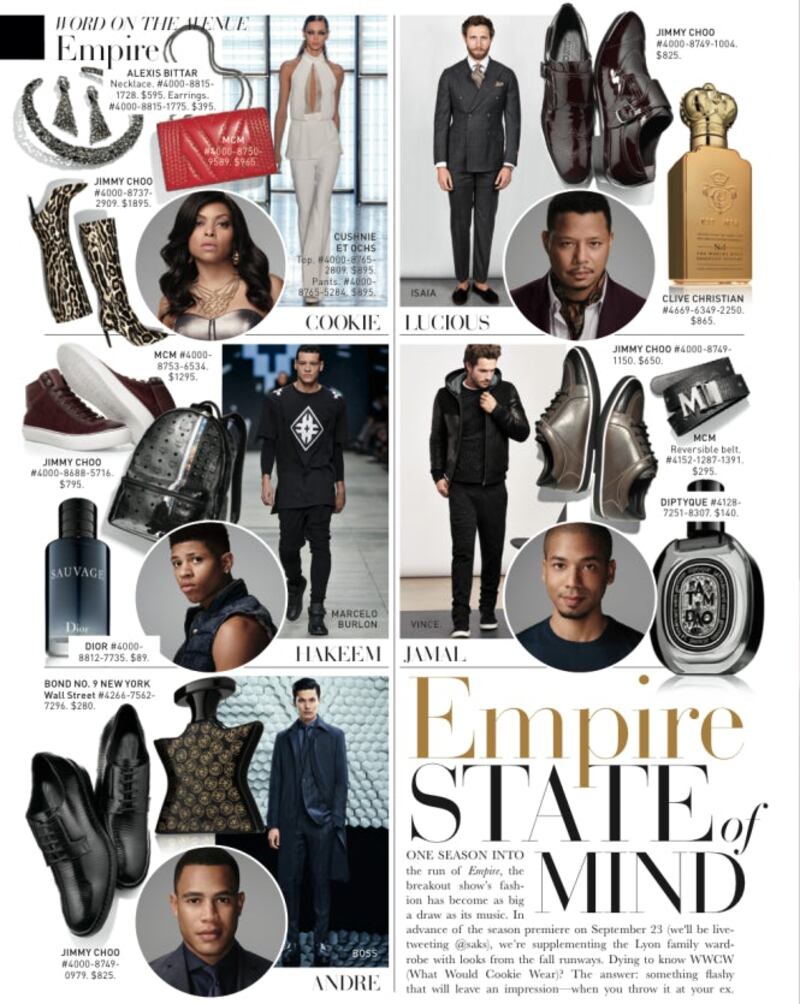
A tear sheet from Saks' Magalog | Source: Courtesy
When it comes to service, many are betting on personalisation. Consider Saks' latest move. Last year, under the supervision of then-president Marigay McKee, the store began publishing a bi-annual, hardcover magalog that featured all the latest and greatest in fashion offerings and was distributed to Saks' top tier of clientele. (About 200 copies were mailed out.) When Metrick replaced McKee in April 2015, he chose to continue publishing the book, but added a twist this fall. Prior to receiving a copy of the final publication, VIPs were sent a binder-clipped, high-resolution preview dotted with hand-written sticky notes from Margolies, who was appointed chief merchant soon after Metrick arrived. "The response we got was unbelievable," Metrik says. "What we realised was that they want access. They want to be a part of it, and we want them to feel like they're a part of it."
Exclusives help set apart a retailer’s selection, often forcing a potential customer to do business with a store whether she intended to or not. “The challenge for brands and the industry as a whole is that there is a lot of distribution out there,” Lee says. “Customers are gravitating more and more toward rare, less distributed items. They want more exclusivity. There are too many points of [sale].”
For Barneys, that means securing exclusive distribution with emerging designers, creating exclusive products with established designers, and, finally, staying out of the concession game. While retailers like Neiman Marcus, Saks, Bergdorf and Bloomingdale's lease space to brands like Chanel, Gucci, and Saint Laurent, Barneys says it has opted to avoid such deals. "One of our defining characteristics is that we've resisted becoming a landlord," says Lee, who also prefers to describe Barneys as a specialty store instead of a department store. "We're curating the best brands with exclusive merchandise. We believe that our customer cares more about that than they care about shop-in-shops that they can find all over America."
At Nordstrom, Kim's curation-driven Pop-Ins concept has been so outwardly successful that co-president Pete Nordstrom expanded her duties to include Space, a permanent section on the floor and website that features emerging designers. The department, launched in August 2015, sells wares from cult Europeans labels including Marques'Almeida, Jacquemus, Vetements; brands that might not otherwise have exposure in the smaller markets where Nordstrom has a foothold.
Retailers are also thinking more about customisation when merchandising individual stores. “Sometimes, the way the department stores are organised, they fail to address the needs of the local market,” Burke says. “They’ve realised that they have to do that. What applies to one store in the middle of America doesn’t necessarily apply elsewhere.” It’s something for Nordstrom and Neiman Marcus — which dominate the southern and western parts of the U.S. — to think about as they gear up to enter the New York City market. In this case, Barneys believes it has a leg up on its competitors. Because its store footprint sizes are comparably small, the mix in each store has always been unique. “We’re thinking local first and foremost,” Lee says. “The Grove [in Los Angeles] is a very different market from Brooklyn, and we’re trying to take that into consideration. Part of it is instinct; part of it is driven by data. It’s always evolving. There is no recipe.”
Outside investments
Though department stores must prioritise fixing what's wrong with the store experience, they are also making strategic investments elsewhere in order to spur overall company growth. In September 2014, Neiman Marcus Group acquired German e-commerce site Mytheresa.com. Meanwhile, Nordstrom acquired men's personal shopping service Trunk Club and flash sales site HauteLook, and has invested in startups like BaubleBar, Bonobos and Shoes of Prey, all brands that are now sold in Nordstrom stores. Saks' saviour has been the off-price market, with the number of Off 5th stores projected to double over the next five years. More recently, reports have swirled that its parent company, Hudson's Bay, is in talks to buy Gilt Groupe for $250 million in order to tap into the flash-sale site's infrastructure and extensive data set. While Barneys has stayed out of the acquisition game, it has made a big bet on content by launching The Window, an online magazine, which recently expanded into print.
Regardless of how they do it, though, making the department store experience magical once again is not going to be easy. “The bottom line is that everything has gotten more competitive,” Burke says. “The ones that are really clear on who their customer is are the ones that are ahead of the game.”
As the German sportswear giant taps surging demand for its Samba and Gazelle sneakers, it’s also taking steps to spread its bets ahead of peak interest.
A profitable, multi-trillion dollar fashion industry populated with brands that generate minimal economic and environmental waste is within our reach, argues Lawrence Lenihan.
RFID technology has made self-checkout far more efficient than traditional scanning kiosks at retailers like Zara and Uniqlo, but the industry at large hesitates to fully embrace the innovation over concerns of theft and customer engagement.
The company has continued to struggle with growing “at scale” and issued a warning in February that revenue may not start increasing again until the fourth quarter.